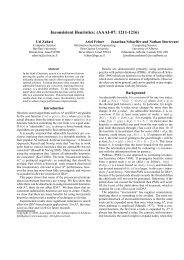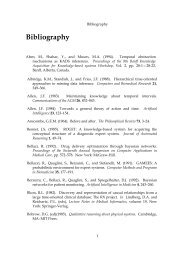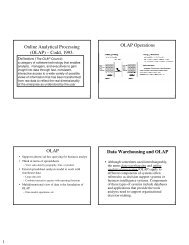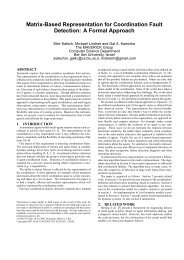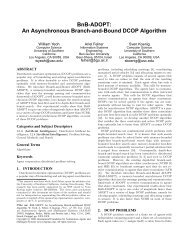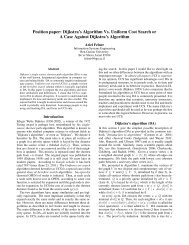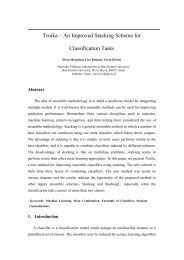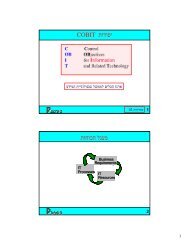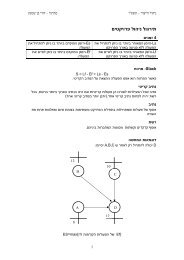The MP-MIX algorithm: Dynamic Search Strategy Selection in Multi ...
The MP-MIX algorithm: Dynamic Search Strategy Selection in Multi ...
The MP-MIX algorithm: Dynamic Search Strategy Selection in Multi ...
Create successful ePaper yourself
Turn your PDF publications into a flip-book with our unique Google optimized e-Paper software.
14<br />
card that his target player just got, and thus always prevent him<br />
from w<strong>in</strong>n<strong>in</strong>g. An additional corollary is that if each player<br />
targets a different player to decrease his evaluation, the game<br />
will become <strong>in</strong>f<strong>in</strong>itely long. To prevent such situations, new<br />
rules are sometimes added to the game. For example, a GoFish<br />
rule prohibit<strong>in</strong>g ask<strong>in</strong>g twice for the same card, or <strong>in</strong> Chess<br />
the rule that prevents 3 recurr<strong>in</strong>g actions.<br />
B. Estimat<strong>in</strong>g the Opponent Impact<br />
When try<strong>in</strong>g to <strong>in</strong>tuitively estimate the OI values for our<br />
three experimental doma<strong>in</strong>s we can see the follow<strong>in</strong>g. In Risk,<br />
one has a direct impact on the merit of other players when<br />
they share borders, as they can directly attack one another.<br />
Shar<strong>in</strong>g a border is common s<strong>in</strong>ce the game board is an<br />
undirected graph with 42 nodes (territories), each with at<br />
least two edges. In Hearts, a player’s ability to directly hurt<br />
a specific player is considerably limited and occurs only on<br />
rare occasions, for <strong>in</strong>stance, when three cards are open on<br />
the table, the specific player has the highest card and he can<br />
choose between pa<strong>in</strong>t<strong>in</strong>g the trick or not. Moreover, s<strong>in</strong>ce<br />
Hearts is an imperfect-<strong>in</strong>formation game, the player can only<br />
believe with a certa<strong>in</strong> probability that his move will have<br />
an impact on its specific target. In Quoridor, a complete<br />
<strong>in</strong>formation, determ<strong>in</strong>istic game, as long as the player still<br />
owns an unplaced wall piece, <strong>in</strong> most cases he can slow down<br />
any of the other opponents.<br />
Comput<strong>in</strong>g the exact value of OI is impractical <strong>in</strong> games<br />
with a large (exponential) number of states. However, we can<br />
estimate it on a large sample of random states. In order to<br />
estimate the OI of Hearts, Risk and Quoridor we did the<br />
follow<strong>in</strong>g. Before <strong>in</strong>itiat<strong>in</strong>g a search to select the action to play,<br />
the player iterated over the other players as target opponents,<br />
and computed their evaluation function. We then counted the<br />
number of game states <strong>in</strong> which the root player’s action would<br />
result <strong>in</strong> more than a s<strong>in</strong>gle heuristic value for one of the target<br />
opponents. For example, consider a game state <strong>in</strong> which the<br />
root player has five possible actions. If the root player’s actions<br />
would result <strong>in</strong> at least two different heuristic values for one of<br />
the target players, we would count this state as an <strong>in</strong>fluential<br />
state, otherwise, when all the available actions result <strong>in</strong> the<br />
same evaluation, we would count it as a non-<strong>in</strong>fluential state.<br />
In Quoridor the process can be simplified as it is equivalent to<br />
count<strong>in</strong>g the number of turns <strong>in</strong> which walls are still available.<br />
In all doma<strong>in</strong>s, we ran 100 tournaments for different search<br />
depths, and computed the OI factor by count<strong>in</strong>g the percentage<br />
of <strong>in</strong>fluential states. We limited our experiments to depth 6 as<br />
it was the maximum depth for the Quoridor and Risk games.<br />
<strong>The</strong> results, depicted <strong>in</strong> Figure 20, show that the OI for<br />
Hearts is very low when the search depth limit is lower than 4<br />
(4% <strong>in</strong> depth 1, and 8% <strong>in</strong> depth 2). For larger depth limits the<br />
OI value monotonically <strong>in</strong>creased but does not exceed 40%.<br />
<strong>The</strong> OI for Risk and Quoridor are estimated around 85%, on<br />
average. From these results we can conclude the follow<strong>in</strong>g:<br />
OI(B<strong>in</strong>go/Yahtzee) = 0 ≺ OI(Hearts) ≈ 0.35 ≺ OI(Risk) ≈<br />
0.85 ≼ OI(Quoridor) ≈ 0.85 ≺ OI(GoFish) = 1<br />
<strong>The</strong> fact that Risk and Quoridor have a higher opponent<br />
impact factor is reflected <strong>in</strong> the experiment results, as the<br />
Estimated Opponent Impact<br />
120<br />
100<br />
80<br />
60<br />
40<br />
20<br />
0<br />
Fig. 20.<br />
1 2 3 4 5 6<br />
<strong>Search</strong> Depth<br />
Hearts Risk Quoridor<br />
Estimat<strong>in</strong>g the Opponent Impact values<br />
relative performance of <strong>MIX</strong> is much higher than <strong>in</strong> the Hearts<br />
doma<strong>in</strong>. In both Risk and Quoridor players have a larger<br />
number of opportunities to act aga<strong>in</strong>st the lead<strong>in</strong>g player than<br />
<strong>in</strong> Hearts. In Hearts even after reason<strong>in</strong>g that there is a lead<strong>in</strong>g<br />
player that should be the ma<strong>in</strong> target for pa<strong>in</strong>ted tricks, the<br />
number of states which one could choose to act aga<strong>in</strong>st the<br />
leader are limited. When look<strong>in</strong>g at expert human players<br />
<strong>in</strong> action, we can often observe how the weaker players try<br />
to tactically coord<strong>in</strong>ate to subdue the leader. An <strong>in</strong>terest<strong>in</strong>g<br />
observation from the Hearts graph is the jump <strong>in</strong> OI between<br />
depths three and four, which can be expla<strong>in</strong>ed by the fact that<br />
at depth four the trick is searched completely and the effect<br />
on the opponents is always taken <strong>in</strong>to account.<br />
An important question which still rema<strong>in</strong>s open after observ<strong>in</strong>g<br />
the results, concerns the relation between the characteristics<br />
of the game and the benefit which players ga<strong>in</strong> when<br />
switch<strong>in</strong>g to a paranoid approach. Naturally, the improvement<br />
that a player will ga<strong>in</strong> when us<strong>in</strong>g the <strong>MP</strong>-Mix strategy<br />
depends on his evaluation function and the threshold value. For<br />
<strong>in</strong>stance, we can easily f<strong>in</strong>d an evaluation function <strong>in</strong> which<br />
the Paranoid and the MaxN approaches will always yield the<br />
same result (e.g., simply pick a function which returns 1 for<br />
w<strong>in</strong>n<strong>in</strong>g states and 0 otherwise), or, as seen above, we can set<br />
the threshold values to such which result <strong>in</strong> no changes <strong>in</strong> the<br />
<strong>algorithm</strong> at all.<br />
VI. CONCLUSIONS<br />
Generaliz<strong>in</strong>g adversarial search <strong>algorithm</strong>s to more than<br />
two players is a challeng<strong>in</strong>g task. <strong>The</strong> MaxN and Paranoid<br />
<strong>algorithm</strong>s are two contrast<strong>in</strong>g approaches, where the first<br />
assumes that each player maximizes its own heuristic value<br />
and the second assumes that each player tries to m<strong>in</strong>imize the<br />
root player’s heuristic value.<br />
Based on observations of human players’ behaviors <strong>in</strong><br />
s<strong>in</strong>gle-w<strong>in</strong>ner multi-player games, we presented the <strong>MP</strong>-Mix<br />
<strong>algorithm</strong> which <strong>in</strong>terleaves both <strong>algorithm</strong>s by runn<strong>in</strong>g the<br />
Paranoid <strong>algorithm</strong> <strong>in</strong> situations where he is lead<strong>in</strong>g the<br />
game by some predef<strong>in</strong>ed threshold, the Directed Offensive<br />
<strong>algorithm</strong> when it is be<strong>in</strong>g led by some predef<strong>in</strong>ed threshold,<br />
and otherwise the MaxN <strong>algorithm</strong>. <strong>The</strong> <strong>MP</strong>-Mix <strong>algorithm</strong><br />
dynamically changes the assumption about the opponents’<br />
behavior, thus it overcomes a basic shortcom<strong>in</strong>g of the other



